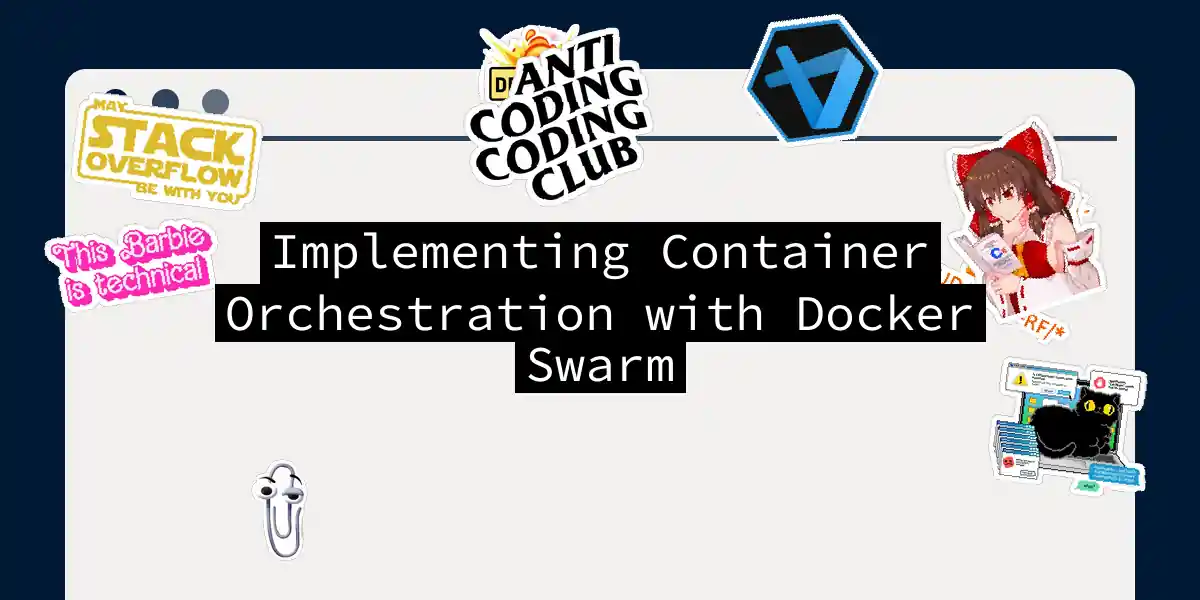Introduction to Container Orchestration
In the world of software development, managing multiple containers can quickly become a daunting task. This is where container orchestration comes into play. Container orchestration is the process of automating the deployment, management, and scaling of containers. Among the various tools available for container orchestration, Docker Swarm stands out as a simple yet powerful solution.
What is Docker Swarm?
Docker Swarm is an in-built orchestration tool within the Docker ecosystem. It allows you to create and manage a cluster of Docker nodes, ensuring high availability, load balancing, and scalability. Unlike Kubernetes, which is more complex and feature-rich, Docker Swarm is known for its simplicity and ease of use.
Components of Docker Swarm
A Docker Swarm cluster consists of two main types of nodes:
- Manager Nodes: These nodes are responsible for managing the cluster. They maintain the state of the cluster, schedule services, and handle the orchestration tasks. Manager nodes can also run containers.
- Worker Nodes: These nodes execute the containers as assigned by the manager nodes. Worker nodes can be added or removed as needed to scale the cluster.
Setting Up a Docker Swarm Cluster
Setting up a Docker Swarm cluster is relatively straightforward. Here’s a step-by-step guide to get you started:
Prerequisites
- Ensure Docker is installed on all the nodes that will be part of the cluster.
- Make sure the nodes can communicate with each other.
Initializing the Swarm
To initialize the Swarm, you need to designate one of the nodes as the manager node. Here’s how you can do it:
sudo docker swarm init --advertise-addr <manager-node-ip>
For example:
sudo docker swarm init --advertise-addr 192.168.10.11
This command will generate a token that other nodes will use to join the cluster.
Joining Nodes to the Swarm
To add worker nodes to the cluster, use the token generated during the initialization process:
sudo docker swarm join --token <token> <manager-node-ip>:2377
For example:
sudo docker swarm join --token SWMTKN-1-0c77d9x5mph6k6zizn93290degg1z2c25rotgbabxrwx4sh0by-f03hbqskhbszllpt4vbb95qvv 192.168.10.11:2377
Verifying the Cluster
You can verify the nodes in your cluster using the following command:
sudo docker node ls
This will list all the nodes in your Swarm cluster.
Managing Services with Docker Swarm
In Docker Swarm, services are the core concept for deploying and managing applications. Here’s how you can create and manage services:
Creating a Service
To create a service, you can use the docker service create command. Here’s an example of creating a simple web server service:
sudo docker service create --name my-web-server --replicas 3 -p 80:80 nginx
This command creates a service named my-web-server with three replicas of the nginx image, mapping port 80 on the host to port 80 in the container.
Listing Services
To list all the services running in your cluster, use the following command:
sudo docker service ls
Scaling Services
You can scale the number of replicas for a service using the docker service update command:
sudo docker service update --replicas 5 my-web-server
This command scales the my-web-server service to five replicas.
Security in Docker Swarm
Security is a critical aspect of any container orchestration system. Here are some key security features in Docker Swarm:
Node Authentication and Encryption
Each node in the Swarm cluster is protected by authentication and TLS encryption. This ensures secure communication between nodes.
Secret Management
Docker Swarm supports secret management, which allows you to securely store sensitive data such as passwords and API keys. You can create a secret using the docker secret create command:
echo "my_secret_data" | sudo docker secret create my_secret -
You can then reference this secret in your service definitions.
Network Architecture
Docker Swarm supports overlay networks, which allow containers to communicate with each other across different nodes. Here’s how you can create an overlay network:
sudo docker network create --driver overlay my-overlay-network
You can then specify this network in your service definitions to ensure that containers can communicate with each other.
Conclusion
Docker Swarm is a powerful and easy-to-use tool for container orchestration. Its simplicity and ease of setup make it an excellent choice for smaller to medium-sized projects or companies that do not require the full feature set of Kubernetes. With its robust security features, support for overlay networks, and easy service management, Docker Swarm can help you efficiently manage and scale your containerized applications.
Final Thoughts
Container orchestration is not just about managing containers; it’s about ensuring your applications are highly available, scalable, and secure. Docker Swarm, with its user-friendly interface and robust features, makes it an ideal choice for many DevOps teams. So, the next time you’re considering how to manage your containerized applications, give Docker Swarm a try – it might just be the swarm of activity your project needs to thrive.
